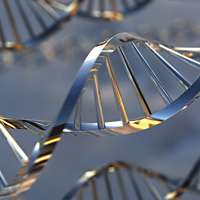DNA to go: Texas A&M chemical engineer aims for DNA lab-on-a-chip

When Dr. Victor Ugaz talks about "catch-and-release," he means DNA, not fish. DNA is known to most of us these days through crime shows, but crime scene investigators and police detectives aren't the only ones who use DNA analysis. DNA identification is also used to diagnose diseases or detect biological agents and toxins. Ugaz, an assistant professor in the Artie McFerrin Department of Chemical Engineering at Texas A&M University, is working to miniaturize a sprawling DNA lab so that components needed for DNA analysis are available in a tiny lab-on-a-chip about the size of a business card.
He's already worked out a novel scheme to perform the series of reactions that allow scientists to rapidly copy the often trace amounts of DNA for analysis. Now, in a paper in the March 28 issue of the Proceedings of the National Academy of Sciences (Vol. 103 No. 13, 4825-4830), Ugaz and Ph.D. student Faisal A. Shaikh have retreated a step: isolating and concentrating small amounts of DNA that would otherwise be difficult to analyze.
"We've found a way to take a dilute DNA sample and concentrate it," Ugaz said. "A lot of times, the genomic material you're looking for is in your sample but at very low concentrations. Using our device, DNA can be concentrated to a much higher level so we can detect it more easily."
In the paper, "Collection, focusing and metering of DNA in microchannels using addressable electrode arrays for portable low-power bioanalysis," Ugaz and Shaikh present their scheme for concentrating and focusing a minute sample of DNA in tiny spaces called microchannels.
The scheme involves placing a series of small electrodes at set intervals along the bottom of a microchannel. A DNA sample is injected into the channel and a small voltage (1 Volt) is applied across the first pair of electrodes in the series. Because opposites attract, the negatively charged DNA migrates toward the positively charged anode and accumulates there, making it possible to "catch" the DNA sample. Switching off the voltage and reapplying it between the second and third electrodes will then "release" the DNA allowing it to be collected at the third electrode.
By repeating this sequential catch and release process, the DNA concentration can be progressively increased. Labeling the sample with a fluorescent dye allows the stepwise increase in concentration from electrode to electrode to be directly observed. After enough catch-and-release steps have been performed to raise the concentration to a desired level, the collected DNA can then be dispensed and used to perform a variety of analysis tests.
And all on a device the size of a business card.
"We're working on developing the components needed to build miniaturized lab-on-a-chip devices" Ugaz said. "The simplicity of this design makes it attractive for portable and inexpensive analysis systems that could be used in areas where there's no access to large DNA labs."
Source: Texas A&M University
















